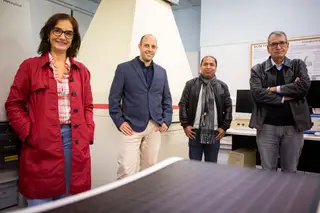The renewable energy sector is constantly seeking out new ways of increasing the absorption of light by solar panel cells. The aim is to reduce the thickness and weight of these cells and allow them to be turned into lightweight, flexible materials that can be used to produce electrical energy.
The progress of studies in this area is helping to change the traditional idea that photovoltaic panels can only be used on roofs and in power plants. According to Manuel João Mendes, assistant professor at the Nova University Lisbon School of Science and Technology, “they will become an ever-increasing part of our daily lives, in car roofs, clothing and any device exposed to the sun”. The researcher stresses that “all we will need is a flexible solar cell to power all our consumer electronics over the day”.
Recently, researchers from the Nova University Lisbon School of Science and Technology (FCT) and from the University of York, in the United Kingdom, came up with a new design for solar panel cells featuring checkerboard patterns, which significantly increases their ability to harness sunlight when compared to more traditional models. One of a series of studies conducted in this area by the FCT Materials Science Department, which had already led to in increases in efficiency of up to 50% compared to traditional photovoltaic panels, “this work consisted of the design of an even more advanced structure, which increases the efficiency of photovoltaic panels by 125% in relation to the most widely used pattern”, explains Manuel João Mendes, the lead investigator in this project in Portugal. “The method is simple, and enables photonic structures to be adapted to any type of cell and not just the silicon variety used in the study”, he adds. This means that “from now on we can design an optimal structure for each device using other types of technology”, he emphasises.

The CEMOP/CENIMAT team of researchers, with Elvira Fortunato, Manuel João Mendes, Sirazul Haque and Rodrigo Martins
The aim of the study was to use photonics, the science of generating, emitting, transmitting, modulating, processing, amplifying and detecting light, “manipulating it in such a way that it becomes trapped in the cells of the solar panels, or to enhance the coupling of light with the materials comprising the cells”, explains Manuel João Mendes. It needs to be retained until it has been completely absorbed.
LOWER MANUFACTURING COSTS
Until now, the main problem with regard to the use of solar cells has been the difficulty in converting the entire spectrum of sunlight into electricity. “A large amount was either lost or reflected, rendering the efficiency of the process very low”, says the researcher, explaining that “the idea of these optical solutions is exactly that, to make better use of the entire spectrum of the sunlight that reaches the Earth, and in a more efficient manner”.
The cells currently available on the market are very thick and, therefore, rigid and difficult to handle and carry. “The availability of materials that absorb light more intensively enables us to produce thinner and more flexible models, at lower manufacturing costs”, says Manuel João Mendes. This means they can be used in a wide range of applications, mainly in consumer electronics. “These photovoltaic panels are totally flexible, carpets that can be rolled up and inserted in clothing, for example, bringing photovoltaic energy closer and more accessible to consumers”, explains the researcher, adding that his department has already produced a number of prototype solar backpacks with built-in cells that “enable you to charge your phone or computer when you're in the sun”.

The new design of photonic structures is capable of trapping sunlight firmly in photovoltaic cells, whereby they function as a waveguide. In addition to significantly increasing the efficiency of converting light into electricity, it enables us to cut production costs and reduce the thickness of our devices.
